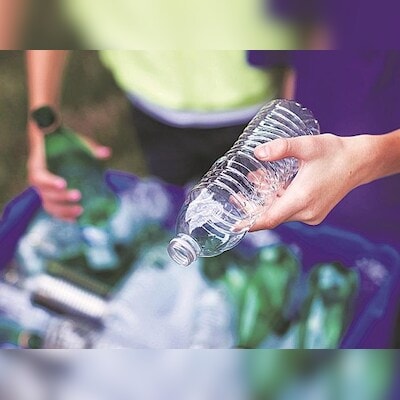Because plastic is everywhere, no single measure can completely eliminate it from your life.
Microplastics are everywhere. These tiny plastic particles, often smaller than the width of a human hair, have been found in the food we eat, the liquids we drink, and throughout the human body, including the lungs, brain, blood, and breast milk.
Although researchers are still determining the exact impacts on human health, microplastics (and their smaller variant, nanoplastics) pose a dual threat. The particles themselves can cause harm, as can the chemicals they contain. A recent study linked plastics in blood vessel plaque to the risk of heart attack, stroke, or death from any cause. Other research has found that plastic exposure can increase the risk of cancer, Parkinson’s disease, and male infertility.
The ubiquity of plastic makes it impossible to completely avoid it. However, there are steps that can be taken to minimize its presence.
“I totally understand, and everybody else does, that plastic is a huge part of our society, but there are some direct exposures that we can reduce,” says Sheela Sathyanarayana, a professor of pediatrics at the University of Washington who studies endocrine-disrupting chemicals in plastics.
Use less plastic, period.
Some exposure to microplastics comes from the environment: airborne particles enter the body when we breathe, for example, while plastics present in bodies of water accumulate in seafood. But there are other, more proximate sources. Sathyanarayana says the “easiest and most accessible way” to limit exposure is to reduce the amount of plastic used.
Simple steps, such as switching from bottled water to tap water, can make a difference. According to one study, a one-liter bottle of water contains an average of 240,000 plastic fragments. Previous research estimated that an average American who drank tap water instead of bottled water would consume significantly fewer plastic particles.
Keep plastics out of the kitchen
It’s not just bottled water. Food storage containers, cutting boards and many other kitchen items are often made of plastic or contain plastic. Even tea bags can be made from materials that contain plastic, says Mark Wiesner, a professor of civil and environmental engineering at Duke University who studies how plastics break down.
Fortunately, many of those same kitchen items also come in glass or stainless steel, while wooden cutting boards can replace plastic ones. Making the switch is especially important because of heat exposure, which can cause plastics to break down more quickly.
“Absolutely do not heat food in plastic in the microwave,” says Gillian Goddard, a New York endocrinologist who writes for Parentdata, which provides information on pregnancy, parenting and perimenopause. Tempered glass, such as Pyrex, is a good alternative for heating food.
When using plastic items, Goddard recommends hand-washing them (the heat and abrasion of the dishwasher can spread particles to other dishes) and throwing them away or reusing them once they become scratched. She also advises never reusing single-use plastics, such as takeout bags and containers, to store food.
Choose clothes made from natural fibers
Textiles made from synthetic fibres are a common and often overlooked source of microplastic exposure, particularly when they are washed or dried. Plastic-free alternatives include natural fibres such as wool, cotton and linen.
When washing synthetic fabrics is unavoidable, there are some ways to minimize harm to the environment, including washing full loads, using cold water, and air drying as much as possible.
Keep the air clean
Plastic particles often end up in the air, for example when they are kicked up by tires or in bubbles on the surface of the ocean. If you’re walking outdoors, a high-quality mask may be your best bet to minimize inhalation.
However, a HEPA air filter can be installed at home to keep the air clean. Filters trap many particles, although smaller ones can pass through. Sathyanarayana also recommends that people remove their shoes in their homes to limit the recirculation of dust.
Imperfect solutions
Because plastic is everywhere, there are no single measures that will completely eliminate it from your life. Goddard says it’s hard to even know how much harm current recommendations are doing: Plastic exposure is so ubiquitous that it’s hard to find control groups for experiments.
But small steps don’t hurt, and reducing plastic dependency has a positive impact on the environment overall. “If you can do those simple things without disrupting your life too much, you’re probably doing something beneficial,” Goddard says.
Mitigating plastic exposure is particularly important for people who are already more vulnerable to health impacts, says Sathyanarayana, including children and pregnant women.
But making real progress in tackling the global plastic problem will ultimately require systemic solutions, and both Goddard and Sathyanarayana are keen to see governments step up. The United Nations Intergovernmental Negotiating Committee on Plastic Pollution is working on what could become a legally binding treaty on plastics, but countries remain divided over its scope, particularly any provisions mandating less plastic production.
First published: August 31, 2024 | 17:08 IS
Disclaimer:
The information contained in this post is for general information purposes only. We make no representations or warranties of any kind, express or implied, about the completeness, accuracy, reliability, suitability or availability with respect to the website or the information, products, services, or related graphics contained on the post for any purpose.
We respect the intellectual property rights of content creators. If you are the owner of any material featured on our website and have concerns about its use, please contact us. We are committed to addressing any copyright issues promptly and will remove any material within 2 days of receiving a request from the rightful owner.

